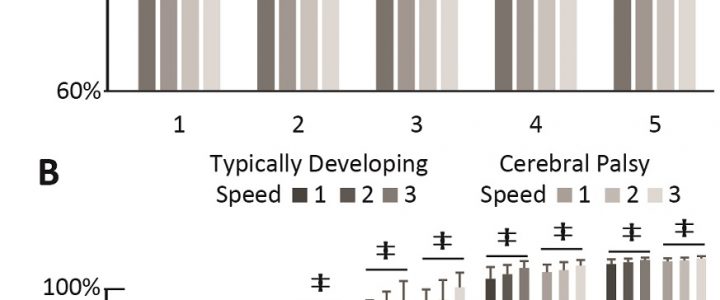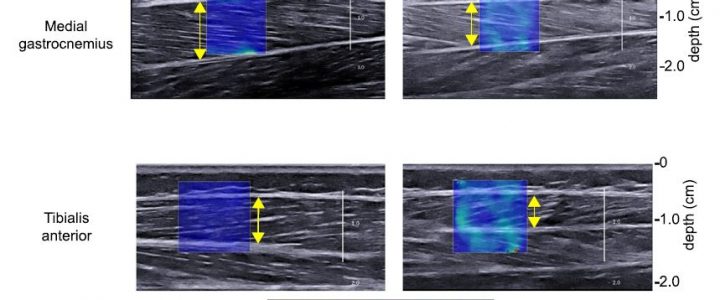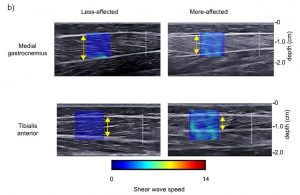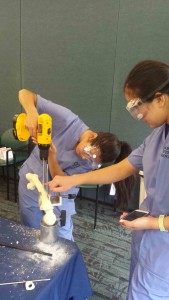After presenting her work at the national American Academy of Orthotists and Prosthetists (AAOP) in Orlando, FL, Sasha was invited to present her work locally at the Northwest chapter of AAOP here in Bellevue. Great job sharing about your research, Sasha!
Publications
BR Shuman, M Goudriaan, L Bar-On, MH Schwartz, K Desloovere, KM Steele (2016) “Repeatability of muscle synergies within and between days for typically developing children and children with cerebral palsy.” Gait & Posture.

Journal article in Gait and Posture:
Filtering parameters impact the results from muscle synergy analyses.
 Abstract: Muscle synergies are typically calculated from electromyographic (EMG) signals using nonnegative matrix factorization. Synergies identify weighted groups of muscles that are commonly activated together during a task, such as walking. Synergy analysis has become an emerging tool to evaluate neuromuscular control; however, the repeatability of synergies between trials and days has not been evaluated. The goal of this study was to evaluate the repeatability of synergy complexity and structure in unimpaired individuals and individuals with cerebral palsy (CP). EMG data were collected from eight lower-limb muscles during gait for six typically developing (TD) children and five children with CP on two separate days, over three walking speeds. To evaluate synergy complexity, we calculated the total variance accounted for by one synergy (tVAF1). On a given day, the average range in tVAF1 between gait cycles was 18.2% for TD and 19.1% for CP. The average standard deviation in tVAF1 between gait cycles was 4.9% for TD and 5.0% for CP. Average tVAF1 calculated across gait cycles was not significantly different between days for TD or CP participants. Comparing synergy structure, the average (standard deviation) within day correlation coefficients of synergy weights for two or more synergies were 0.89 (0.15) for TD and 0.88 (0.15) for CP. Between days, the average correlation coefficient of synergy weights for two or more synergies was greater than 0.89 for TD and 0.74 for CP. These results demonstrate that synergy complexity and structure averaged over multiple gait cycles are repeatable between days in both TD and CP groups.
Abstract: Muscle synergies are typically calculated from electromyographic (EMG) signals using nonnegative matrix factorization. Synergies identify weighted groups of muscles that are commonly activated together during a task, such as walking. Synergy analysis has become an emerging tool to evaluate neuromuscular control; however, the repeatability of synergies between trials and days has not been evaluated. The goal of this study was to evaluate the repeatability of synergy complexity and structure in unimpaired individuals and individuals with cerebral palsy (CP). EMG data were collected from eight lower-limb muscles during gait for six typically developing (TD) children and five children with CP on two separate days, over three walking speeds. To evaluate synergy complexity, we calculated the total variance accounted for by one synergy (tVAF1). On a given day, the average range in tVAF1 between gait cycles was 18.2% for TD and 19.1% for CP. The average standard deviation in tVAF1 between gait cycles was 4.9% for TD and 5.0% for CP. Average tVAF1 calculated across gait cycles was not significantly different between days for TD or CP participants. Comparing synergy structure, the average (standard deviation) within day correlation coefficients of synergy weights for two or more synergies were 0.89 (0.15) for TD and 0.88 (0.15) for CP. Between days, the average correlation coefficient of synergy weights for two or more synergies was greater than 0.89 for TD and 0.74 for CP. These results demonstrate that synergy complexity and structure averaged over multiple gait cycles are repeatable between days in both TD and CP groups.
SSM Lee, D Gaebler-Spira, LQ Zhang, WZ Rymer, KM Steele, (2016) “Use of shear wave ultrasound elastography to quantify muscle properties in cerebral palsy.” Clinical Biomechanics

Journal article in Clinical Biomechanics:
Kat Steele partnered with Sabrina Lee from Northwestern University and the Rehabilitation Institute of Chicago to investigate shearwave ultrasound elastography as a new tool to quantify changes in muscle properties in cerebral palsy.
 Abstract: Individuals with cerebral palsy tend to have altered muscle architecture and composition, but little is known about the muscle material properties, specifically stiffness. Shear wave ultrasound elastography allows shear wave speed, which is related to stiffness, to be measured in vivo in individual muscles. Our aim was to evaluate the material properties, specifically stiffness, as measured by shear wave speed of the medial gastrocnemius and tibialis anterior muscles in children with hemiplegic cerebral palsy across a range of ankle torques and positions, and fascicle strains. Shear wave speed was measured bilaterally in the medial gastrocnemius and tibialis anterior over a range of ankle positions and torques using shear wave ultrasound elastography in eight individuals with hemiplegic cerebral palsy. B-mode ultrasound was used to measure muscle thickness and fascicle strain. Shear waves traveled faster in the medial gastrocnemius and tibialis anterior of the more-affected limb by 14% (P = 0.024) and 20% (P = 0.03), respectively, when the ankle was at 90°. Shear wave speed in the medial gastrocnemius increased as the ankle moved from plantarflexion to dorsiflexion (less affected: r2 = 0.82, P < 0.001; more-affected: r2 = 0.69, P < 0.001) and as ankle torque increased (less affected: r2 = 0.56,P < 0.001; more-affected: r2 = 0.45, P < 0.001). In addition, shear wave speed was strongly correlated with fascicle strain (less affected: r2 = 0.63, P < 0.001; more-affected: r2 = 0.53, P < 0.001). The higher shear wave speed in the more-affected limb of individuals with cerebral palsy indicates greater muscle stiffness, and demonstrates the clinical potential of shear wave elastography as a non-invasive tool for investigating mechanisms of altered muscle properties and informing diagnosis and treatment.
Abstract: Individuals with cerebral palsy tend to have altered muscle architecture and composition, but little is known about the muscle material properties, specifically stiffness. Shear wave ultrasound elastography allows shear wave speed, which is related to stiffness, to be measured in vivo in individual muscles. Our aim was to evaluate the material properties, specifically stiffness, as measured by shear wave speed of the medial gastrocnemius and tibialis anterior muscles in children with hemiplegic cerebral palsy across a range of ankle torques and positions, and fascicle strains. Shear wave speed was measured bilaterally in the medial gastrocnemius and tibialis anterior over a range of ankle positions and torques using shear wave ultrasound elastography in eight individuals with hemiplegic cerebral palsy. B-mode ultrasound was used to measure muscle thickness and fascicle strain. Shear waves traveled faster in the medial gastrocnemius and tibialis anterior of the more-affected limb by 14% (P = 0.024) and 20% (P = 0.03), respectively, when the ankle was at 90°. Shear wave speed in the medial gastrocnemius increased as the ankle moved from plantarflexion to dorsiflexion (less affected: r2 = 0.82, P < 0.001; more-affected: r2 = 0.69, P < 0.001) and as ankle torque increased (less affected: r2 = 0.56,P < 0.001; more-affected: r2 = 0.45, P < 0.001). In addition, shear wave speed was strongly correlated with fascicle strain (less affected: r2 = 0.63, P < 0.001; more-affected: r2 = 0.53, P < 0.001). The higher shear wave speed in the more-affected limb of individuals with cerebral palsy indicates greater muscle stiffness, and demonstrates the clinical potential of shear wave elastography as a non-invasive tool for investigating mechanisms of altered muscle properties and informing diagnosis and treatment.
Perry Initiative: Inspiring future female engineers and orthopaedic surgeons
Seattle Children’s Hospital hosted the Perry Initiative this weekend to inspire women to pursue careers in engineering and orthopaedic surgery. Dr. Jacquelin Perry was one of the first ten women orthopaedic surgeons in the country and has been a mentor to countless women and men throughout her career. She is known for her work quantifying human movement using tools such as motion analysis, electromyography, and ultrasound. She developed new surgical procedures including methods to straighten spines and inventing the ‘halo’ to immobilize the spine, neck, and head.
 This weekend, 25 women from local high schools, joined surgeons and engineers at Seattle Children’s to learn about common medical tasks and cutting-edge medical technology. They tried their hand at casting, suturing, external/internal bone
This weekend, 25 women from local high schools, joined surgeons and engineers at Seattle Children’s to learn about common medical tasks and cutting-edge medical technology. They tried their hand at casting, suturing, external/internal bone
fixation, and rotator cuff repair.
From the Perry Initiative: “Engineers and orthopaedic surgeons work hand-in-hand to develop safe and effective implants for repairing broken bones, torn ligaments, and worn-out joints. Strong partnerships between surgeons and engineers are essential for improving the performance of orthopaedic implants and creating solutions to unmet clinical needs.”
We agree! Here’s to many future collaborations with diverse teams of engineers and surgeons.
Congratulations, Sasha! She will be presenting at the 2016 AAOP Symposium
 Sasha Portnova will be presenting her work, Open-Source 3D-Printed Hand Orthoses for Individuals with Spinal Cord Injury, at the American Academy of Orthotists and Prosthetists (AAOP) 42nd Academy Annual Meeting and Scientific Symposium, March 9-12th in Orlando, FL. Congratulations, Sasha!
Sasha Portnova will be presenting her work, Open-Source 3D-Printed Hand Orthoses for Individuals with Spinal Cord Injury, at the American Academy of Orthotists and Prosthetists (AAOP) 42nd Academy Annual Meeting and Scientific Symposium, March 9-12th in Orlando, FL. Congratulations, Sasha!
